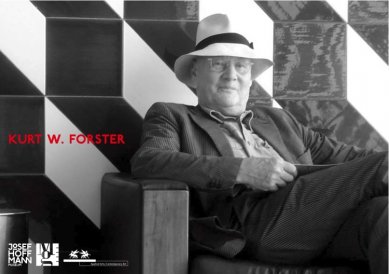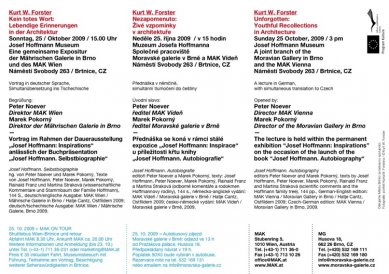
Book launch of J. Hoffmann and lecture by K. W. Foster in Brtnice
The launch of the book Josef Hoffmann. Autobiography and lecture by leading theoretical figure of world architecture Kurt W. Forster Forgotten: Living Memories in Architecture as part of the permanent exhibition Josef Hoffmann: Inspirations at the Museum of Josef Hoffmann.
Sunday afternoon, October 25, 2009, is dedicated to two significant events at the Birthplace of Josef Hoffmann. The long-awaited publication Josef Hoffmann. Autobiography will be launched here, and prominent theoretical architect Kurt W. Forster will visit Brtnice.
The publication of Josef Hoffmann's autobiography was prepared by the Moravian Gallery in Brno in collaboration with MAK — Austrian Museum of Applied and Contemporary Art. The book is available not only in a Czech-German version but also in a German-English version and can be purchased at the MG shops for a discounted price of 249 CZK. Interested readers will find out the opinions of this renowned Art Nouveau architect and designer on his work, and they will also get a glimpse into his private life. The book presents personal insights and memories related to the buildings Hoffmann completed, the origins and functioning of the renowned craft workshops Wiener Werkstätte, which he co-founded, as well as stories about his clients. “His commentary on the construction of the Stoclet Palace, which was recently inscribed on the UNESCO World Heritage List, the sanatorium in Purkersdorf, or the stories that took place in the Primavesi family's country house in Kouty nad Desnou, which is among his most significant realizations, but unfortunately no longer exists in its original form, deserves particular mention. Hoffmann's comments on the foundation and functioning of Wiener Werkstätte, their liquidation, and his unwavering and eventually successful effort to establish new workshops are remarkable. Engaging memories also include a number of names of Hoffmann's collaborators, without whom Viennese Secession and modernism might not have been possible,” clarifies Martina Straková.
Kurt W. Forster (*1935) is among the most significant contemporary architectural theorists. He studied in Berlin, Munich, London, and Zurich. Over three decades, he taught at American universities Yale, Stanford, and MIT. From 1975 to 1977, he was the director of the Swiss Institute in Rome and later the founding director of the Getty Center for the History of Art and the Humanities in California. In addition to books on the Italian Renaissance, classicism, and modernism, he is the author of monographs on contemporary architects such as Eisenman, Gehry, Libeskind, and Mateo. Due to his vast range of knowledge, he is able to seek new themes in architecture and pose entirely new questions. His work is therefore enriching not only for theorists but also for architects and the general public. As part of his lecture Forgotten: Living Memories in Architecture, which will be simultaneously translated from German to Czech, he will discuss how architects perceive and reflect on their own work. Naturally, he will also include his thoughts on Josef Hoffmann. Admission to the lecture is free. Transportation from Brno is provided for a fee of 50 CZK. Departure from the Pražák Palace is at 1 PM, with a return expected at 5 PM. Reservations are necessary at phone numbers 532 169 130, 532 169 131.
The lecture will take place as part of the permanent exhibition Josef Hoffmann. Inspirations, which was opened to the public on June 14, 2009. The establishment of this exhibition is the core of the project “Architecture and Interior Design in Central Europe at the Beginning of the 20th Century”, which aims to explore and present this theme through the examples of two leading architects focusing on interior design. In addition to Josef Hoffmann, it also addresses the work of Dušan Jurkovič.
“Josef Hoffmann was one of the leading figures of the turbulent development of art at the turn of the 19th and 20th centuries. Through his architectural activity and design work associated with leading the craft workshops Wiener Werkstätte, he set their direction during the first half of the 20th century. His unique work has been studied and interpreted by leading world theorists since the 1970s. However, there have been few opportunities to discover how Josef Hoffmann himself viewed his work and life. The recently published book allows the reader to study the text that the architect wrote sometime between 1948 and 1950. In it, he tried to summarize his work from the very beginnings of his life spent in the idyllic hometown of Brtnice, through his studies in Otto Wagner's workshop in Vienna, the founding of Wiener Werkstätte, up to the post-war period.
The autobiography was first published in 1972 as part of the magazine Ver Sacrum. The text was released only in German. At the initiative of the Society of Friends of Josef Hoffmann, a book titled Josef Hoffmann and His Birthplace in Brtnice was published in 1998, which included a Czech translation of the introductory part of the autobiography dedicated to Hoffmann's memories of Brtnice. We now present readers with a book that contains the complete text and is translated into Czech and English. A whole range of information that Hoffmann mentions in the text and might not be clear to some readers for various reasons is explained and described in the second part of the book. Details about the history of Hoffmann's family are supplemented by an extensive family tree that traces from ancestors born in the 17th century to Hoffmann's descendants living today in the United States. Readers are presented with a series of biographical entries on Hoffmann's collaborators, thus giving the book the value of an encyclopedia of modernity of its kind. Thanks to collaboration with the publishing house Hatje Cantz, the book in its German-English version will be available to readers around the world.”
Sunday, October 25, 2009, at 3 PM
Svobody Square 263, Brtnice near Jihlava
The Museum of Josef Hoffmann is a joint workplace of the Moravian Gallery in Brno and the MAK Vienna.Sunday afternoon, October 25, 2009, is dedicated to two significant events at the Birthplace of Josef Hoffmann. The long-awaited publication Josef Hoffmann. Autobiography will be launched here, and prominent theoretical architect Kurt W. Forster will visit Brtnice.
The publication of Josef Hoffmann's autobiography was prepared by the Moravian Gallery in Brno in collaboration with MAK — Austrian Museum of Applied and Contemporary Art. The book is available not only in a Czech-German version but also in a German-English version and can be purchased at the MG shops for a discounted price of 249 CZK. Interested readers will find out the opinions of this renowned Art Nouveau architect and designer on his work, and they will also get a glimpse into his private life. The book presents personal insights and memories related to the buildings Hoffmann completed, the origins and functioning of the renowned craft workshops Wiener Werkstätte, which he co-founded, as well as stories about his clients. “His commentary on the construction of the Stoclet Palace, which was recently inscribed on the UNESCO World Heritage List, the sanatorium in Purkersdorf, or the stories that took place in the Primavesi family's country house in Kouty nad Desnou, which is among his most significant realizations, but unfortunately no longer exists in its original form, deserves particular mention. Hoffmann's comments on the foundation and functioning of Wiener Werkstätte, their liquidation, and his unwavering and eventually successful effort to establish new workshops are remarkable. Engaging memories also include a number of names of Hoffmann's collaborators, without whom Viennese Secession and modernism might not have been possible,” clarifies Martina Straková.
Kurt W. Forster (*1935) is among the most significant contemporary architectural theorists. He studied in Berlin, Munich, London, and Zurich. Over three decades, he taught at American universities Yale, Stanford, and MIT. From 1975 to 1977, he was the director of the Swiss Institute in Rome and later the founding director of the Getty Center for the History of Art and the Humanities in California. In addition to books on the Italian Renaissance, classicism, and modernism, he is the author of monographs on contemporary architects such as Eisenman, Gehry, Libeskind, and Mateo. Due to his vast range of knowledge, he is able to seek new themes in architecture and pose entirely new questions. His work is therefore enriching not only for theorists but also for architects and the general public. As part of his lecture Forgotten: Living Memories in Architecture, which will be simultaneously translated from German to Czech, he will discuss how architects perceive and reflect on their own work. Naturally, he will also include his thoughts on Josef Hoffmann. Admission to the lecture is free. Transportation from Brno is provided for a fee of 50 CZK. Departure from the Pražák Palace is at 1 PM, with a return expected at 5 PM. Reservations are necessary at phone numbers 532 169 130, 532 169 131.
The lecture will take place as part of the permanent exhibition Josef Hoffmann. Inspirations, which was opened to the public on June 14, 2009. The establishment of this exhibition is the core of the project “Architecture and Interior Design in Central Europe at the Beginning of the 20th Century”, which aims to explore and present this theme through the examples of two leading architects focusing on interior design. In addition to Josef Hoffmann, it also addresses the work of Dušan Jurkovič.
“Josef Hoffmann was one of the leading figures of the turbulent development of art at the turn of the 19th and 20th centuries. Through his architectural activity and design work associated with leading the craft workshops Wiener Werkstätte, he set their direction during the first half of the 20th century. His unique work has been studied and interpreted by leading world theorists since the 1970s. However, there have been few opportunities to discover how Josef Hoffmann himself viewed his work and life. The recently published book allows the reader to study the text that the architect wrote sometime between 1948 and 1950. In it, he tried to summarize his work from the very beginnings of his life spent in the idyllic hometown of Brtnice, through his studies in Otto Wagner's workshop in Vienna, the founding of Wiener Werkstätte, up to the post-war period.
The autobiography was first published in 1972 as part of the magazine Ver Sacrum. The text was released only in German. At the initiative of the Society of Friends of Josef Hoffmann, a book titled Josef Hoffmann and His Birthplace in Brtnice was published in 1998, which included a Czech translation of the introductory part of the autobiography dedicated to Hoffmann's memories of Brtnice. We now present readers with a book that contains the complete text and is translated into Czech and English. A whole range of information that Hoffmann mentions in the text and might not be clear to some readers for various reasons is explained and described in the second part of the book. Details about the history of Hoffmann's family are supplemented by an extensive family tree that traces from ancestors born in the 17th century to Hoffmann's descendants living today in the United States. Readers are presented with a series of biographical entries on Hoffmann's collaborators, thus giving the book the value of an encyclopedia of modernity of its kind. Thanks to collaboration with the publishing house Hatje Cantz, the book in its German-English version will be available to readers around the world.”
Martina Straková
The English translation is powered by AI tool. Switch to Czech to view the original text source.


0 comments
add comment






